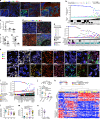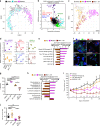Differentiation-state plasticity is a targetable resistance mechanism in basal-like breast cancer
- PMID: 30232459
- PMCID: PMC6145927
- DOI: 10.1038/s41467-018-05729-w
Differentiation-state plasticity is a targetable resistance mechanism in basal-like breast cancer
Abstract
Intratumoral heterogeneity in cancers arises from genomic instability and epigenomic plasticity and is associated with resistance to cytotoxic and targeted therapies. We show here that cell-state heterogeneity, defined by differentiation-state marker expression, is high in triple-negative and basal-like breast cancer subtypes, and that drug tolerant persister (DTP) cell populations with altered marker expression emerge during treatment with a wide range of pathway-targeted therapeutic compounds. We show that MEK and PI3K/mTOR inhibitor-driven DTP states arise through distinct cell-state transitions rather than by Darwinian selection of preexisting subpopulations, and that these transitions involve dynamic remodeling of open chromatin architecture. Increased activity of many chromatin modifier enzymes, including BRD4, is observed in DTP cells. Co-treatment with the PI3K/mTOR inhibitor BEZ235 and the BET inhibitor JQ1 prevents changes to the open chromatin architecture, inhibits the acquisition of a DTP state, and results in robust cell death in vitro and xenograft regression in vivo.
Conflict of interest statement
Andrea Califano is founder, equity holder, consultant, and director of DarwinHealth Inc., a company that has licensed the VIPER algorithm used in this manuscript from Columbia University. Columbia University is also an equity holder in DarwinHealth Inc. Mariano J. Alvarez is an equity holder and consultant of DarwinHealth Inc.
Figures






References
Publication types
MeSH terms
Substances
Grants and funding
- U54 CA209997/CA/NCI NIH HHS/United States
- CA209988/U.S. Department of Health & Human Services | NIH | National Cancer Institute (NCI)/International
- BC103625/U.S. Department of Defense (DOD)/International
- R35 GM124704/GM/NIGMS NIH HHS/United States
- R01 CA129040/CA/NCI NIH HHS/United States
- R01 CA100855/CA/NCI NIH HHS/United States
- P50 GM107615/GM/NIGMS NIH HHS/United States
- T32 GM071338/GM/NIGMS NIH HHS/United States
- CA112970/U.S. Department of Health & Human Services | NIH | National Cancer Institute (NCI)/International
- U01 CA217858/CA/NCI NIH HHS/United States
- U54 CA209988/CA/NCI NIH HHS/United States
- S10 OD021764/OD/NIH HHS/United States
- R35 CA197745/CA/NCI NIH HHS/United States
- P30 CA069533/CA/NCI NIH HHS/United States
- S10 OD012351/OD/NIH HHS/United States
- CA100855/U.S. Department of Health & Human Services | NIH | National Cancer Institute (NCI)/International
- U54 CA112970/CA/NCI NIH HHS/United States
- U01 CA195469/CA/NCI NIH HHS/United States
- CA129040/U.S. Department of Health & Human Services | NIH | National Cancer Institute (NCI)/International
- R01 CA186241/CA/NCI NIH HHS/United States
- 5T32GM071338-09/U.S. Department of Health & Human Services | NIH | National Cancer Institute (NCI)/International
- R01 CA196228/CA/NCI NIH HHS/United States
LinkOut - more resources
Full Text Sources
Other Literature Sources
Medical
Molecular Biology Databases
Miscellaneous

